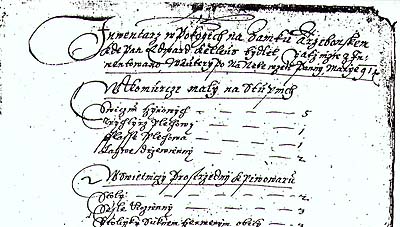Alchemy in Český Krumlov
 The second half of the
16th century is usually called "the golden age of alchemy". Beside
Emperor Rudolf II. von
Habsburg, it was Wilhelm von
Rosenberg who became the most important Maecenas of the
hermetic sciences, especially of alchemy. Around the House of
Rosenberg, in fact, arose a second center of hermetic and alchemic
activity. Not only renowned and lesser known enthusiastic seekers,
but also skilled con artists worked their magic in the Prague
Rosenberg Palace as well as in different seats of Wilhelm's South
Bohemian dominion - in Třeboň, Prachatice, and especially in Český
Krumlov, which used to be called "the South Bohemian Mecca of
alchemists".
The second half of the
16th century is usually called "the golden age of alchemy". Beside
Emperor Rudolf II. von
Habsburg, it was Wilhelm von
Rosenberg who became the most important Maecenas of the
hermetic sciences, especially of alchemy. Around the House of
Rosenberg, in fact, arose a second center of hermetic and alchemic
activity. Not only renowned and lesser known enthusiastic seekers,
but also skilled con artists worked their magic in the Prague
Rosenberg Palace as well as in different seats of Wilhelm's South
Bohemian dominion - in Třeboň, Prachatice, and especially in Český
Krumlov, which used to be called "the South Bohemian Mecca of
alchemists".
 Let's look over some
names connected with this group of Rosenberg magicians. Primarily,
we have to speak about Doctor Tadeáš Hájek z Hájku (1525 - 1600) -
a physician and a Rennaissance natural scientist.
Let's look over some
names connected with this group of Rosenberg magicians. Primarily,
we have to speak about Doctor Tadeáš Hájek z Hájku (1525 - 1600) -
a physician and a Rennaissance natural scientist.
The first meeting of the 18-year-old Wilhelm with Hájek took place at the end of 1553. At the time, the natural scientist had published a prognosis for the following year based on an astrological analysis. The prognosis agreed admirably with and inspired Wilhelm's political projects, and much of it came true in the course of the year. The affair was a political struggle with the Dukes of Plavno. In 1556, we meet Hájek as a renowned physician accompanying Wilhelm von Rosenberg during his war campaign to Hungary. Among other things, Hájek was an excellent botanist and was very helpful during the arrangement of the Rosenberg gardens in Prague, Český Krumlov and Kratochvíle. Hájek's book "A Treatise of Comet and Celestial Signs", dating from 1580 and dedicated to both the brothers - Wilhelm and Peter Wok von Rosenberg - became well known. Because of his wide natural historical knowledge and honesty, Hájek was in demand for evaluating would-be court alchemists.
The next name of importance was doctor Václav Lavín, who was later titled "of Ottenfeld". He was the personal physician of both of the last Rosenbergs and worked for Sir Wilhelm as well. He acquired his alchemist knowledge during his studies in France where he is said to have created a tincture of transformation. But we do not know whether he tried to carry out any transmutations. He worked for the Rosenbergs together with a Prague burgher, Martin Kluger. Lavín was in practice in Český Krumlov and Prague as well as in Třeboň. His name was mentioned for the first time at the Český Krumlov Castle in 1595, in the chronicle of Václav Břežan.
In the gallery of personages in the Rosenberg Court, we cannot omit a classic of Czech Renaissance alchemy - Bavor Rodovský from Husitřany (1526 - 1566). He descended from an old Czech family of squires. He inherited his first name from his grandfather Bavor the Senior who was believed to be a wizard and could supposedly produce gold. In actuality, however, he either couldn't or didn't produce much of it because his family wasn't even wealthy enough for the native manor to provide sustenance for five descendants, Bavor the Junior being one of them. Three of Bavor's brothers left the manor to devote themselves to military service; he himself, as he could not afford to go on to Prague University, stayed at home and studied on his own. He never achieved any university education but was evidently so gifted that he even surpassed the knowledge of many of his educated peers. His scientific interests were very versatile. He devoted himself to alchemy, astronomy, and mathematics, but was also interested in history and philosophy. He did not leave out the practical side of life, as can be seen by his set of cooking recipes. Until the age of 40, he devoted himself to alchemy in a more or less theoretical way.
He began with practical experiments as soon as he obtained some means of support from his parent's heritage and from the dot of his wife, Voršila ze Šelndorfu. He bought the manor Radostav u Nechanic where he set up an alchemist laboratory. His experiments there became so expensive that he had to borrow money from a usurer living in Nový Bydžov named Áron Munk, resulting in his imprisonment for debts in the Prague Black Tower. He wrote a long letter from here to Sir Wilhelm von Rosenberg, in which he asked him, as the highest burgrave, to allot him a special prison where he could devote himself undisturbed to literary work. Not only did he ask for help, but he also tried to use Wilhelm's resources to get close to the ideas of a Renaissance natural historical scientist, Theophrastus Paracelsus, who had given a new direction to alchemy and used chemicals to produce medications. He thus placed alchemy into the service of medicine. In 1574 Bavor offered Wilhelm, who ended up bailing him out of prison, a translation of the book "Secreta Aristotelis". Nevertheless, it still wasn't enough to pay off all his debts, so in 1575 Bavor Rodovský was obliged to sell Radostov. His wife took his son and left him to go live with her parents; in 1576, we can already find Bavor in the Rosenberg laboratories in Prague, Třeboň and in Český Krumlov. He stayed in the Rosenbergs' employment for two years. Then he was engaged in Prague, in the laboratories of Emperor Rudolf II. von Habsburg, whom he highly respected. Rodovský spent the last years of his life at the residence of his friend Jan Zbyněk Zajíc z Budyně, where he died in 1600.
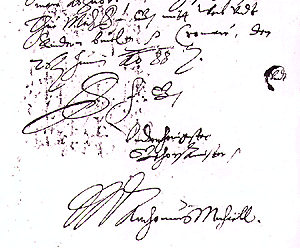 In contrast with the
enthusiastic, honest, but financially unpractical Bavor Rodovský,
we have another alchemist from Český Krumlov, Anton Michael
from Ebbersbach. He is mentioned to have been in Wilhelm's
service from 1565, and he was in practice in Český Krumlov maybe
for the longest time of all the alchemists. On the occasion of
Wilhelm's fourth marriage with Polyxena von Pernstein in 1587, he
promised to produce for his Maecenas "conservationem senectutis" -
an age-stopping remedy, or something like the so-called "elixir of
life". Anton Michael from Ebbersbachu had an important position in
Český Krumlov - he was given control over the direction and
management of the local alchemist laboratories and over a garden
arranged for their use. In July 1592, he was to have produced one
of the promised elixirs of life. He wrote to Wilhelm about it,
saying that "he already possesses the remedy in his hands and his
Lord can have it at any time". The remedy was said to be the
well-known "aurum potabile", the gold drink that rejuvenates and
extends life, curing all known diseases. But even the "aurum
potabile" didn't work and Wilhelm von Rosenberg died on August 31,
1592. His brother, Peter Wok, had a more skeptical attitude towards
the alchemists, and the first one to feel it sharply was actually
Anton Michael from Ebbersbachu. On command of this last Rosenberg,
he was imprisoned in a cell near the first gate of the Český
Krumlov Castle, close to the Bear Moat. And there he ended his life
on May 15, 1593. As he himself declared in prison, he had lent
different people about 78 thousand sixties of Meiseen groschen
which originated from Wilhelm's treasury. So Peter Wok von
Rosenberg confiscated his possessions in the name of the castle. We
can judge from the mentioned sum of money and from his real
property that he did not live modestly. He owned a house in
Široká
No. 77 and a manor near Kájovská brána (Kájov Gate). The site
of his last repose is situated in the building of the Minorite
monastery, in the cloister, where his tombstone has been preserved
to this day.
In contrast with the
enthusiastic, honest, but financially unpractical Bavor Rodovský,
we have another alchemist from Český Krumlov, Anton Michael
from Ebbersbach. He is mentioned to have been in Wilhelm's
service from 1565, and he was in practice in Český Krumlov maybe
for the longest time of all the alchemists. On the occasion of
Wilhelm's fourth marriage with Polyxena von Pernstein in 1587, he
promised to produce for his Maecenas "conservationem senectutis" -
an age-stopping remedy, or something like the so-called "elixir of
life". Anton Michael from Ebbersbachu had an important position in
Český Krumlov - he was given control over the direction and
management of the local alchemist laboratories and over a garden
arranged for their use. In July 1592, he was to have produced one
of the promised elixirs of life. He wrote to Wilhelm about it,
saying that "he already possesses the remedy in his hands and his
Lord can have it at any time". The remedy was said to be the
well-known "aurum potabile", the gold drink that rejuvenates and
extends life, curing all known diseases. But even the "aurum
potabile" didn't work and Wilhelm von Rosenberg died on August 31,
1592. His brother, Peter Wok, had a more skeptical attitude towards
the alchemists, and the first one to feel it sharply was actually
Anton Michael from Ebbersbachu. On command of this last Rosenberg,
he was imprisoned in a cell near the first gate of the Český
Krumlov Castle, close to the Bear Moat. And there he ended his life
on May 15, 1593. As he himself declared in prison, he had lent
different people about 78 thousand sixties of Meiseen groschen
which originated from Wilhelm's treasury. So Peter Wok von
Rosenberg confiscated his possessions in the name of the castle. We
can judge from the mentioned sum of money and from his real
property that he did not live modestly. He owned a house in
Široká
No. 77 and a manor near Kájovská brána (Kájov Gate). The site
of his last repose is situated in the building of the Minorite
monastery, in the cloister, where his tombstone has been preserved
to this day.
Another important personage of the period of the last Rosenbergs was a native from Český Krumlov who went down in Bohemian history for both medicine and alchemy. This was Jakub Hořčický z Tepence, also well known under his Latin name Sinapius. He was born in 1575 in Český Krumlov. As a boy, he was engaged as a scullion to the newly founded local Jesuit College. Because of his capabilities, he was recommended to follow higher studies; he graduated at the local Latin gymnasium and later practiced under the local pharmacist Martin Schafner where he learned how to carry out different chemical processes, especially distillations. After leaving Český Krumlov, he studied logic and physics at Prague University (1598 - 1600), then went for some time to practice in Jindřichův Hradec as manager of the local botanical garden belonging to a religious order. Hořčický took advantage of the practical knowledge he gained in the pharmacy laboratory in Český Krumlov as well as of the deeper knowledge of the potency of medicinal plants he gained in the botanical garden in Jindřichův Hradec and put them to successful use at his next place of work. It was again a botanical garden, this time in Prague, belonging to the Jesuit College in the Clementinum. In the garden, Hořčický-Sinapius grew medicinal plants from which he made and distilled different therapeutic tinctures, ointments and so-called theriacs or quack remedies. These medicaments enjoyed general respect and used to be called "hořčické vody", (waters from Hořčice). Hořčický even managed to cure Emperor Rudolf II. von Habsburg of a disorder that the other doctors were unable to remedy. He was consequently named the Emperor's personal physician and the distillator of the Emperor's Castle Laboratories. On October 20, 1608, he was raised to knighthood with the right to use a coat-of-arms. In the general conception of the coat-of-arms and in the arrangement of heraldic figures we can find many common parallels with the contemporary language of alchemistic symbols . After the death of Rudolf II., Jakub Hořčický z Tepence was engaged for several years as manager of the Castle in Mělník. He spent the last years of his life in seclusion, in Prague's Klementinum, where he died in 1622.
In the enumeration of outstanding alchemists who practiced in the Rosenberg background, we cannot leave out the English alchemists Edward Kelley and John Dee. They came to Bohemia for the first time in 1584. They found accommodations in Prague at the place of Tadeáš Hájek z Hájku who let them also take their entrance examination. Later, John Dee is said to have carried out a transmutation of mercury into gold in front of Rudolf II, then he offered Rudolf his crystal ball and a magical anthracite mirror. Two years later, in June of 1586, both the Englishmen were suspected of political intrigue and had to leave the country very quickly. But shortly afterwards Wilhelm von Rosenberg allowed them to return to Bohemia, to his South Bohemian dominion. John Dee and his family dwelt in Třeboň from September 14, 1586. He enjoyed his South Bohemian asylum so much that he named his son, born there in February, Theodorus Trebonianus - Theodorus of Třeboň. According to written documents, Edward Kelley also used to visit Český Krumlov from Třeboň. The documents are silent about John Dee, but we can be sure that even he visited Český Krumlov personally during his stay in Třeboň. John Dee left Třeboň in March 1589, then later on Edward Kelley left for Prague to the laboratories of Emperor Rudolf II.
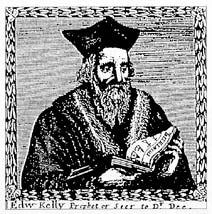
|
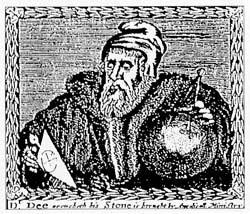
|
In addition to the above named personages, Linhart Wichperger of Erbach also belonged among Wilhelm's group of alchemists. He worked in Prachatice around 1566. There was also Jaroš Griemiller z Třebska who practiced in the service of the Rosenbergs in the 70s; to Wilhelm he dedicated his preciously illuminated alchemistic miscellany written in Czech and dating from 1578 (today in the National Library in Prague). This fundamental work, entitled "Rosarium philosophorum" meaning "Rose Garden of Philosophers" ranks among the classical achievements of alchemistic literature. It contains a description of the preparation of the stone of sages.
According to his master, the renowned engineer of the pond and lake system in South Bohemia and Rosenberg regent Jakub Krčín of Jelčany devoted himself to alchemy. But his interest in alchemy was simply for pleasure, not profit. He set up a laboratory at Nový hrádek in Křepenice near Sedlčany.
 On the recommendation of
Václav Vřesovec of Vřesovice (1532 - 1583), a Prague supporter of
alchemy, the renowned Italian alchemist Claudius Syrrus came into
Wilhelm's employ as well. We have a preserved text of the work
contract between the alchemist and the Rosenberg sovereign as
recorded by the chronicler Václav Březan. In the contract listing
seven conditions, it is written that the alchemist reserves the
right to be spiritually and physically free and independent, and
makes it a condition not to be disturbed by anybody, with the
personal exception of Wilhelm von Rosenberg. Should the occasion
arise that the philosophical stone is actually produced, it is
arranged that Claudius Syrrus receives a half share of it. In
addition, a note was anchored in the contract saying that a purely
positive result was not guaranteed.
On the recommendation of
Václav Vřesovec of Vřesovice (1532 - 1583), a Prague supporter of
alchemy, the renowned Italian alchemist Claudius Syrrus came into
Wilhelm's employ as well. We have a preserved text of the work
contract between the alchemist and the Rosenberg sovereign as
recorded by the chronicler Václav Březan. In the contract listing
seven conditions, it is written that the alchemist reserves the
right to be spiritually and physically free and independent, and
makes it a condition not to be disturbed by anybody, with the
personal exception of Wilhelm von Rosenberg. Should the occasion
arise that the philosophical stone is actually produced, it is
arranged that Claudius Syrrus receives a half share of it. In
addition, a note was anchored in the contract saying that a purely
positive result was not guaranteed.
The younger of the two last Rosenbergs, Wilhelm's brother Peter Wok von Rosenberg, was also interested in alchemy. He is even known as an author of a treatise on distillation. Nevertheless, he was not able to compete with Wilhelm's financial capacity to sponsor such activities.

|
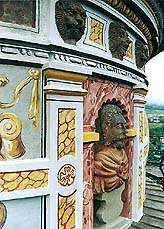
|
In conclusion, we must mention two architectural monuments of Český Krumlov containing elements of hermetic symbolism. One in particular is the Český Krumlov Castle Tower (Castle No.59 - Castle Tower) which became, after being reconstructed in the 1580s by the Italian master builder Baldassare Maggi of Arogne, a visible symbol of Wilhelm's life-long efforts in seeking the path towards the Great Task. The second interesting building is a corner house - Latrán No. 53. On the, front facing Latrán, we can see Renaissance lunette paintings presenting the ten stages of human life. At the side opening into Klášterní ulička (Monastery Lane) are sgrafitti with spectacular geometrical symbols in which we see pictures of alchemistic furnaces, strange vessels, and apparently a geometrically expressed description of the Great Task. Up to the present day, nobody has managed to satisfactorily explain these unique figures.

|

|
Owing to Wilhelm von Rosenberg, South Bohemia and Český Krumlov became an equivalent, albeit opposite, pole of Rudolf's Prague. Alchemy is not only a historical predecessor of chemistry as is usually thought - alchemy was, and still is, a science concerning universal analogies of matter. In this sense it forms an organic part of hermetic philosophy.
(jko)






